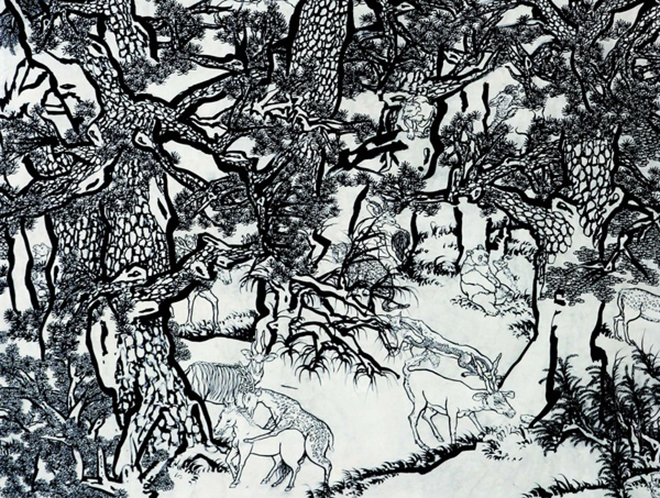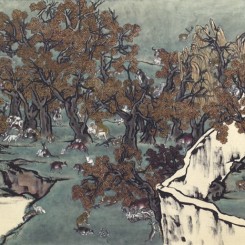INK STUDIO
Curator: Dr. Britta Erickson
Opening: May 18, 2014, 2:30 – 4:00 pm
Dates: May 19, 2014 – August 31, 2014
墨齋 is pleased to announce its forthcoming exhibition This Is Still Landscape Painting featuring new works by artist Yang Jiechang (b. 1956 in Foshan, Guangdong province, China). With this exhibition, Yang presents his audience with a range of paintings that are both disturbing and beautiful. Power, violence and terror are central concerns in Yang’s art and yet so are transcendence of form, sublimation of self and universal love. When Yang deploys seductively masterful technique in service of psychologically disturbing or even horrifying imagery, our experience approaches the sublime-a realization of the inhuman that is both monstrous and transcendent.
In his pursuit of both the sublime and the engaged, Yang’s artistic practice is perhaps unique in the history of traditional Chinese brush and ink painting. Since the late eighteenth and early nineteenth centuryD isasters of War and Los Caprichos series by Goya (1746-1828), European artists have taken it as their role to comment on society’s follies and disasters. Chinese brush artists, by contrast, continued to embrace the Confucian, Daoist and Buddhist moral norms long-established for the fine arts of poetry, calligraphy and brush painting. As a contemporary artist, Yang Jiechang rejects this traditional norm and embraces the role of social actor.

Yang Jiechang, “Black and White Mustard Seed Garden”(detail) [Tale of the 11th Day series], 2009-2014, ink and mineral pigments on silk, mounted on canvas, 8 panels, each 280 x 141 cm
Yang Jiechang is equally talented when working in expressive calligraphic ink brushwork. In this mode of painting Yang cites the freehand style of painting (写意 xieyi, literally meaning ‘writing of ideas’) traditionally associated with a literary or poetic treatment of morally positive subject matter. For This Is Still Landscape Painting he has created a variety of works in this manner, with some depicting poignant vignettes, iconic wartime images of individuals, and others displaying the artist’s exhortations, for example “Do Not Move,” “Everything Is Important,” and “Whip.” The major piece After the Battle 1914-2014 portrays a succinctly rendered fallen soldier and his horse overlaid against a background bombed-out city that fades from view. Finally, a pair of sculptures, Young Man with Flowers 1924-2014 1 and Tieguai Li 1924-2014 1 shows the state of an individual, initially hopefully holding flowers, and later with devastating injuries.
As underscored by the title of After the Battle 1914-2014, this year marks the hundredth anniversary of the start of the First World War. Perhaps we can see the exhibition as a whole as a call to avoid disastrous large-scale violence. Nature itself is neutral-flowers are still flowers even if painted by Hitler, and the landscape is still a landscape, even when it is witness to the folly of humankind.

Yang Jiechang, “Mustard Seed Garden 1,” 2010, ink and mineral pigments on silk, mounted on canvas, 95.5 x 121.5 cm
Already in his student days at the Guangzhou Academy of Fine Arts, Yang Jiechang had adopted the position of provocateur, a position reinforced by his experiences in China’s Cultural Revolution when youth were encouraged to rebel. Following graduation he tried to withdraw from art to study with Buddhist and Daoist masters. This led him to search for simplicity when he returned to painting. In 1988 he moved to Europe, where he has remained, living between Paris and a village near Heidelberg. In 1989 he participated in both the seminal Contemporary Chinese Art exhibition at the National Art Museum in Beijing and the equally paradigm-changing exhibition Les magiciens de la terre at the Centre Georges Pompidou where he created his artworks on the scene. Since then his work has been included in numerous major international exhibitions, including Advance through Retreat(Rockbund Art Museum, Shanghai, 2014), Ink Art: Past as Present in Contemporary China (Metropolitan Museum, New York, 2013-2014), Yuandao(Hong Kong Museum of Art, Hong Kong, 2013), Reactivation – Shanghai Biennale (Shanghai, 2012), The World Belongs to You (Palazzo Grassi, Fondation F. Pinault, Venice, 2011), Hareng Saur: Ensor et contemparain(MSK and S.M.A.K., Ghent, Belgium, 2010), Lyon Biennial (Lyon, 2009), Qui a peur des artistes ? Une sélection d’œuvres de la Fondation François Pinault(Musée de Dinard, Dinard, 2009), all from the last five years.
Also during the last five years his work has been the subject of solo exhibitions at the OCT Art & Design Gallery, Shenzhen (2012), Centre d’art contemporain, Rennes (2011), and the Associazione Culturale Cantiere d’Arte Alberto Moretti-Galleria Schema, Prato (2009), among others, and later this year Yang Jiechang – I often do bad things will open at the Phoenixhalle in Hamburg.
Public institutions that have collected Yang Jiechang’s work include the Hong Kong Museum of Art; Hong Kong University Art Museum; Shenzhen Fine Art Institute; Guangzhou Museum of Art; Cantor Art Centre, Stanford University; Berkeley Art Museum; Fukuoka Art Museum; Museum for Arts and Crafts, Hamburg; Centro Cultural Arte Contemporaneo, Mexico City; The World Bank, Washington, D.C.; Rockefeller Foundation; French Ministry of Culture. Such private collections as the François Pinault Foundation; Ullens Foundation, Switzerland; Yageo Art Foundation, Taiwan; and Eslite Inc., Taiwan also include his work.
Dr. Britta Erickson, Ink Studio’s Artistic Director and curator of This Is Still Landscape Painting, is an independent scholar and curator living in Palo Alto, California. She has curated major exhibitions at the Arthur M. Sackler Gallery, Washington, D.C. (2001-2002) and the Cantor Center for Visual Arts, Stanford (2005). In 2007 she co-curated the Chengdu Biennial, which focused on ink art, and in 2010 she was a contributing curator for Shanghai: Art of the City (Asian Art Museum, San Francisco). Ms. Erickson is on the advisory boards of the Ink Society (Hong Kong) and Three Shadows Photography Art Centre (Beijing), as well as the editorial boards of Yishu: Journal of Contemporary Chinese Art and ART AsiaPacific. In 2006 she was awarded a Fulbright Fellowship to conduct research in Beijing on the Chinese contemporary art market. Dr. Erickson received her Ph.D. in Chinese Art History from Stanford University.
Yang Jiechang is one of ten artists featured in the documentary film series, The Enduring Passion for Ink, produced by Britta Erickson, and his work and life is the subject of a forthcoming scholarly publication, edited by Dr. Erickson. The publication will appear approximately six months after the closure of the exhibition and will be distributed in the USA by D.A.P.

![Yang Jiechang, “Black and White Mustard Seed Garden”(detail) [Tale of the 11th Day series], 2009-2014, ink and mineral pigments on silk, mounted on canvas, 8 panels, each 280 x 141 cm 杨诘苍,《十一日谈系列:白描芥子园》 ( 局部), 2009-2014年, 墨,矿物彩,绢,裱于布面, 280 x 141 cm/张,共8 张](http://www.randian-online.com/wp-content/uploads/2014/05/20140501_yjc_pr_cn_bricks-265x195.jpg)
![Yang Jiechang, “Black and White Mustard Seed Garden”(detail) [Tale of the 11th Day series], 2009-2014, ink and mineral pigments on silk, mounted on canvas, 8 panels, each 280 x 141 cm 杨诘苍,《十一日谈系列:白描芥子园》 ( 局部), 2009-2014年, 墨,矿物彩,绢,裱于布面, 280 x 141 cm/张,共8 张](http://www.randian-online.com/wp-content/uploads/2014/05/20140501_yjc_pr_cn_bricks-245x245.jpg)
